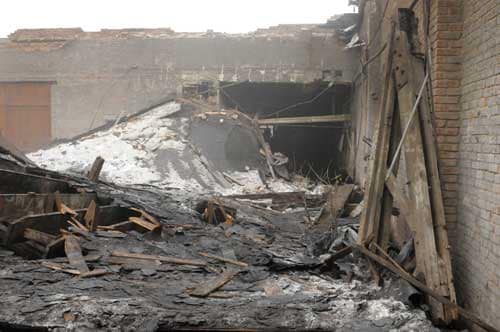Two Career Fire Fighters Die and 19 Injured in Roof Collapse during Rubbish Fire at an Abandoned Commercial Structure – Illinois
The free Adobe Acrobat Reader may be needed to open some of the files on this page. You can download Acrobat Reader from adobe.com
Executive Summary ( Full Report HERE ) or at NIOSH
On December 22, 2010, a 47-year-old male (Victim # 1) and a 34-year old male (Victim # 2), both career fire fighters, died when the roof collapsed during suppression operations at a rubbish fire in an abandoned and unsecured commercial structure. The bowstring truss roof collapsed at the rear of the 84-year old structure approximately 16 minutes after the initial companies arrived on-scene and within minutes after the Incident Commander reported that the fire was under control. The structure, the former site of a commercial laundry, had been abandoned for over 5 years and city officials had previously cited the building owners for the deteriorated condition of the structure and ordered the owner to either repair or demolish the structure. The victims were members of the first alarm assignment and were working inside the structure. A total of 19 other fire fighters were hurt during the collapse.

Collapse scene as viewed from building rear facing building front. Note portion of bowstring truss leaning against wall at right side of photo.
(Photo courtesy of fire department)
Contributing Factors
- Lack of a vacant / hazardous building marking program within the city
- Vacant / hazardous building information not part of automatic dispatch system
- Dilapidated condition of the structure
- Dispatch occurred during shift change resulting in fragmented crews
- Weather conditions including snow accumulation on roof and frozen water hydrants
- Not all fire fighters equipped with radios.
Key Recommendations
- Identify and mark buildings that present hazards to fire fighters and the public
- Use risk management principles at all structure fires and especially abandoned or vacant unsecured structures
- Train fire fighters to communicate interior conditions to the Incident Commander as soon as possible and to provide regular updates
- Provide battalion chiefs with a staff assistant or chief's aide to help manage information and communication
- Provide all fire fighters with radios and train them on their proper use
- Develop, train on, and enforce the use of standard operating procedures that specifically address operations in abandoned and vacant structures

No comments:
Post a Comment